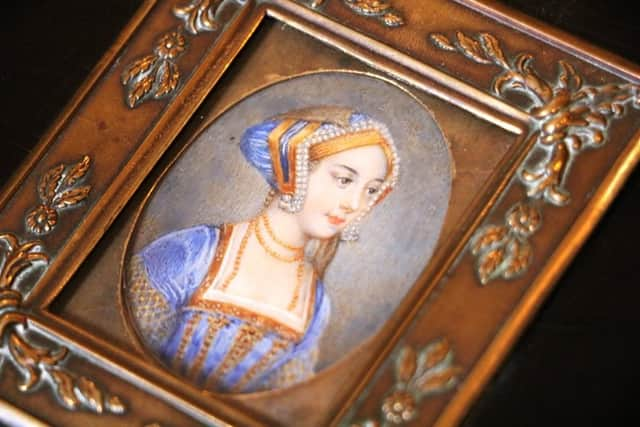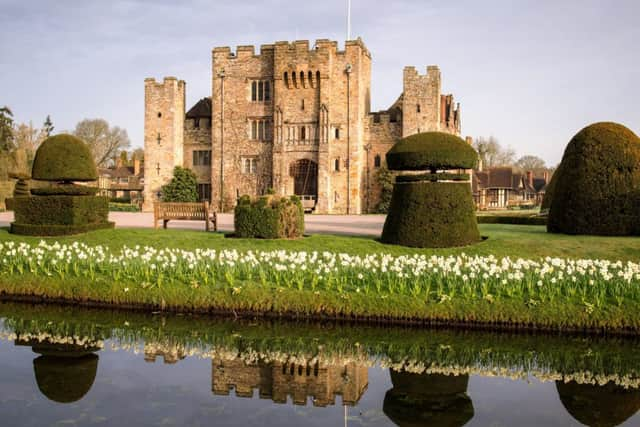Life and times of queen consort Anne Boleyn ... her most beguiling story


New exhibition illustrates artistic, cultivated and cultured woman with very keen intellect schooled in arts, crafts and sport, historian Andrew Southam explains.
Some 500 years ago, in spring 1522, a cultivated young lady of olive skin and beguiling dark eyes enthralled England’s nobility at a London pageant.
Anne Boleyn had arrived at the court of King Henry VIII.


Ten years later she became one of England’s most influential queen consorts.
How did this story start?
Advertisement
Hide AdAdvertisement
Hide AdNew exhibition Becoming Anne: Connections, Culture, Court at her family home of Hever Castle in Kent tells the tale.
Even today, we know less than we know more about Anne and her relationship with Henry. Historians are even unsure when she was born, probably between 1501 and 1507.
Her great-grandfather started the Boleyn rise moving from Norfolk landowner to wealthy London merchant.
His grandson, Thomas Boleyn, made a bold decision for the time: he educated not only his son George but also his daughters Mary and Anne.
Advertisement
Hide AdAdvertisement
Hide AdIn 1513 he sent teenage Anne to royal courts in the Low Countries, what is modern day Holland and Belgium, and then France for a dazzling European schooling.
These centres of culture and artistic learning instructed her in intellect, the arts, crafts and sport.
Academic subjects like history, philosophy, exquisite French and even chess honed her mind.
Expertise in music including several instruments like the lute, embroidery and knowledge of art developed her tastes.
Advertisement
Hide AdAdvertisement
Hide AdAnd an acquaintance with falconry, archery and riding kept her up with the men.
Perhaps badly for Anne, she also encountered radical ideas about church authority – influences affecting her deeply and instilling reformist tendencies.
Most convincing was her mastery of courtly love, the rituals and manners of dancing, singing and conversation that allure potential suitors.


Historian and assistant curator Dr Owen Emmerson says this upbringing made Anne “a woman of diverse qualities, possessing a fine command of literature, languages, arts, politics, and radical religious ideas. It was marked that you would have mistaken her for a Frenchwoman born.”
Advertisement
Hide AdAdvertisement
Hide AdKing Henry, who himself spoke languages, wrote books and composed music besides hunting and ‘real tennis’ passions, sought the very French culture Anne exuded for his own court.
His roving eye also fell on her youthful beauty.
They met sometime around 1526 from when besotted Henry chased her for seven years.
An astute Anne spurned his advances until her position was secure – she wasn’t going to be another ‘next woman’.
Her political abilities and French language helped him achieve important discussions with France’s king in 1532.
Advertisement
Hide AdAdvertisement
Hide AdIn return, Henry made her Marquess of Pembroke, banishing his wife Catherine of Aragon from the court.
Anne used her new political sway to rescue persecuted exiles and protect reforming clergy from heresy accusations.
Meanwhile Henry yearned for a legitimate son which his wife, now 40, could not provide.
Anne offered prospects of male heir
Anne therefore offered him prospects of a male heir and French elegance. But how to divorce Catherine when the Pope granted separation for exceptional reasons only?
Advertisement
Hide AdAdvertisement
Hide AdAnne provided an answer. She told him about religious reformer William Tyndale’s ideas of a king not the Pope controlling the Church. This started events that shaped her life and Britain’s future.
Archbishop of Canterbury Thomas Cranmer married them secretly in late 1532, Anne fell pregnant, Cranmer annulled Henry’s marriage to Catherine and Anne was crowned Queen Consort in a lavish ceremony.
But she had reached the pinnacle. In September 1533 she gave birth not to a boy but a girl.
Failure to produce a male heir slowly turned her fortune. She was beheaded three years later!
Advertisement
Hide AdAdvertisement
Hide AdHer downfall is a familiar story. A baby daughter and several miscarriages - the last in January 1536 - denied Henry his son. Her enemies grew, despising her extravagance, her opposition to Rome and her usurpation of Catherine - she was never popular in public.
While her influence waned at court, her effect on England’s religion reached a climax. She had contributed to
England’s break from the Catholic Church: the 1534 Supremacy Act freed Henry from Rome and started the English reformation.
Henry now searched for an heir and a fresh lover, landing on Jane Seymour, a maid to Anne who became wife number three. His aides engineered Anne’s demise through allegations of adultery, incest and treachery.
Advertisement
Hide AdAdvertisement
Hide AdHistorians debate her innocence or guilt, mostly around the more plausible charge of adultery.
Archbishop Cranmer cancelled her marriage to Henry in May 1536. He could because the King was now supreme ruler of a Church of England, a condition Anne helped create.
Two days later, Anne dressed in red walked to the gallows with the same confidence shown in life. A French axe man paid for by Henry did the deed.
Hever Castle holds a poignant reminder of Anne. A tiny prayer book called a Book of Hours, which she likely read in her final days, bears her own inscription: ‘remember me when you do pray, that hope doth lead from day to day’.


Advertisement
Hide AdAdvertisement
Hide AdDr Emmerson says the exhibition shows what made Anne “the fiercely intelligent and devastatingly cultured woman known to history. This exhibition charts the very specific influences and opportunities which moulded Anne Boleyn into the woman who captured the eye of the king, who divided a kingdom, and who gave birth to the most famous English monarch in history”.


And through this famous monarch, England’s warrior queen Elizabeth I, Anne’s spirit and intelligence lived on.
The exhibition runs until November. Full details are at Becoming Anne: New exhibition on her childhood home hevercastle.co.uk website.